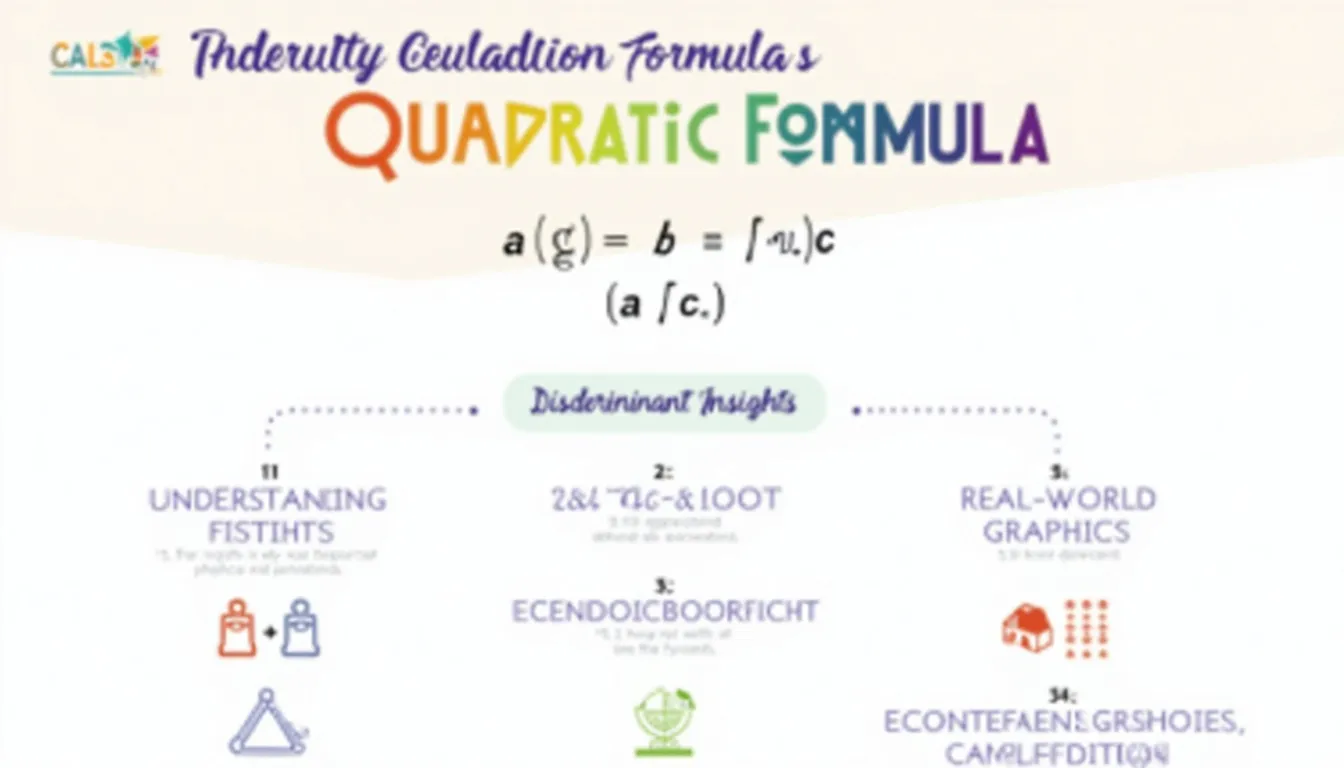Quadratic Equation Calculator
Is this tool helpful?
How to use the tool
- 1. Fill in coefficient a (non-zero). Example: 2 or -1.5.
- 2. Enter coefficient b. Example: 9 or 0.5.
- 3. Enter coefficient c. Example: 4 or -2.
- 4. Press “Calculate”. The tool returns both roots, the discriminant Δ, and the nature of the roots.
Underlying formula
The calculator applies the quadratic formula:
$$x = rac{-b \pm \sqrt{b^{2}-4ac}}{2a}$$
Example A: real roots
Equation 2x² + 9x + 4 = 0.
- Δ = 9² − 4·2·4 = 49.
- x₁ = (-9 + 7)/4 = -0.5.
- x₂ = (-9 − 7)/4 = -4.
Example B: complex roots
Equation −1.5x² + 0.5x − 2 = 0.
- Δ = 0.25 − 12 = −11.75.
- Real part = −0.5 / (-3) ≈ 0.1667.
- Imaginary part = √11.75 / (-3) ≈ ±1.1431i.
- Roots: 0.1667 ± 1.1431i.
Quick-Facts
- Handles real coefficients from -1 × 10⁶ to 1 × 10⁶ (IEEE 754 double range) (IEEE Std 754-2019).
- Outputs four-decimal precision to aid manual checking (NIST, Digital Library of Math Functions).
- Complex roots are returned as conjugate pairs, ensuring coefficient symmetry (Weisstein, MathWorld).
- Discriminant instantly categorises root type—real distinct, repeated, or complex (Stewart, 2015).
FAQ
What is a quadratic equation?
A quadratic equation has degree 2 and standard form ax² + bx + c = 0, where a ≠ 0 (Boyce & DiPrima, 2017).
Why must coefficient a be non-zero?
If a = 0, the expression becomes linear, so the quadratic formula no longer applies (Larson, 2022).
How does the discriminant guide you?
Δ > 0 ⇒ two real roots, Δ = 0 ⇒ one repeated root, Δ < 0 ⇒ complex roots (“Quadratic Formula,” Britannica.com).
How precise are the displayed roots?
The tool rounds to four decimals, but internal computation keeps full double-precision (≈15 digits) for accuracy (IEEE 754-2019).
Can you solve equations with decimal coefficients?
Yes. The algorithm treats decimals exactly like integers because JavaScript numbers use binary64 floats (MDN Web Docs).
Does the calculator support complex coefficients?
No. It assumes real a, b, c; complex inputs require symbolic algebra systems (Maplesoft Guide, 2020).
How do you verify the results?
Substitute each root into the original equation; the left side should evaluate to 0 within rounding error (Stewart, 2015).
What’s the educational value?
“Seeing Δ change while coefficients vary deepens understanding of parabolic behavior,” notes the Common Core math framework (CCSSI, 2019).
Important Disclaimer
The calculations, results, and content provided by our tools are not guaranteed to be accurate, complete, or reliable. Users are responsible for verifying and interpreting the results. Our content and tools may contain errors, biases, or inconsistencies. Do not enter personal data, sensitive information, or personally identifiable information in our web forms or tools. Such data entry violates our terms of service and may result in unauthorized disclosure to third parties. We reserve the right to save inputs and outputs from our tools for the purposes of error debugging, bias identification, and performance improvement. External companies providing AI models used in our tools may also save and process data in accordance with their own policies. By using our tools, you consent to this data collection and processing. We reserve the right to limit the usage of our tools based on current usability factors.







